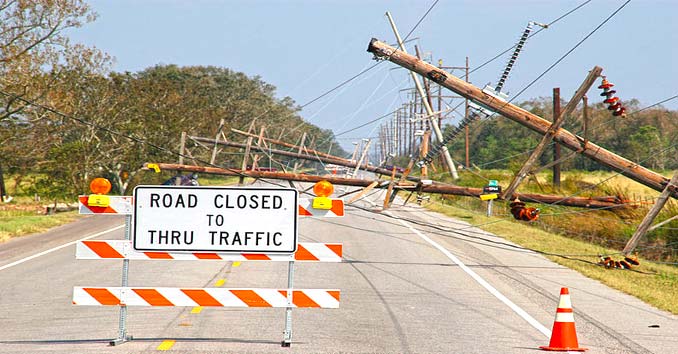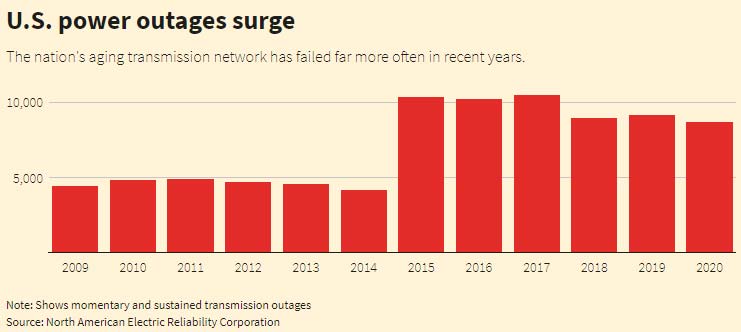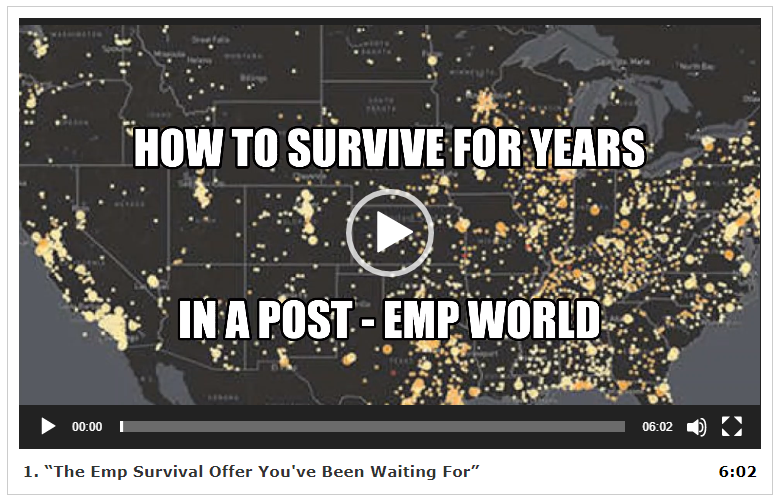Power Grid Threats: From Ground Zero to Safety- Detailed Steps for Surviving Power Grid Failure, Managing Fallout Risks, and Building Effective Shelters
What was once considered something that can only happen in a science fiction novel is now a very real possibility: the complete shutdown of our entire electrical grid.
Power grid failures are nothing new; in fact, during the winter of 1965 the United States experienced one of the worst power outages in its history. Over 30 million people from seven northeastern states and the province of Ontario in Canada were plunged into darkness when maintenance workers mistakenly tripped a safety relay. Almost forty years later, the same area was hit by the great Northeast blackout of 2003, where over 55 million people experienced power outages as a result of a software bug.
While most power outages are caused by storms or utility company mistakes, a growing number of these outages are being blamed on everything from our deteriorating electrical infrastructure to terrorists and hackers.
History of Major United States Power Outages
Over the last couple of decades, power outages have affected just about every American. These outages cause the average U.S. electrical utility customer to go without power for an estimated 214 minutes every year, costing the U.S. economy up to an estimated $55 billion annually.
The United States has a long history of major power outages that have disrupted daily life, caused significant economic losses, and even resulted in the loss of life. From the Northeast Blackout of 1965 to Hurricane Katrina in 2005, let’s take a closer look at some of the most significant power outages in U.S. history.
Northeast Blackout of 1965
On November 9, 1965, a faulty relay at a power plant in Ontario, Canada, led to a power surge that caused a chain reaction and resulted in a massive blackout that affected over 30 million people across the northeastern United States and parts of Canada. The outage lasted several hours and left many stranded without transportation or communication.
New York City Blackout of 1977
On July 13, 1977, a series of lightning strikes caused significant power outages in New York City, plunging the entire city into darkness. The blackout lasted for over 25 hours, caused over 9 million to lose power, and led to widespread looting and arson in several neighborhoods.
Utah Goes Dark in 1981
January 1981: Almost the entire state of Utah goes dark after prisoners on a work assignment accidentally knocked out transmission lines. 1.5 million people, in nearly all of Utah, as well as parts of southeastern Idaho and southwestern Wyoming lost power.
The Loma Prieta earthquake
October 1989: The Loma Prieta earthquake knocked out power to over 1.4 million people in Northern California due to damaged electrical substations.
The Western U.S. Energy Crisis of 2000 and 2001
2000-2001: The Western U.S. Energy Crisis of 2000 and 2001 hit California causing rolling blackouts that lasted for over 12 months.
The Midwest Grid Failure of 2003
On August 14, 2003, a software error in the alarm system of a power plant in Ohio caused a power outage that affected over 55 million people across the Northeastern and Midwestern United States and parts of Canada. The outage lasted several days in some areas and led to billions of dollars in economic losses.
Hurricane Katrina of 2005
On August 29, 2005, Hurricane Katrina landed on the Gulf Coast, causing widespread destruction and power outages in Louisiana, Mississippi, and Alabama. The storm knocked out power to over one million people, leaving many without electricity, clean water, or access to basic necessities for weeks.
Superstorm Sandy of 2012
On October 29, 2012, Superstorm Sandy and the Mid-Atlantic storms of 2012 struck the Northeastern United States, causing massive power outages that affected over eight million people across 17 states. The storm surge caused significant damage to power lines and substations, leaving many without electricity for weeks and causing over $50 billion in economic losses.
The list above is only a fraction of the power outages that have been experienced over the last couple of decades, and experts are warning about a frightening increase in non-disaster-related outages. Significant power outages have risen from 76 in 2007 to 307 in 2011.
Why 90% of People Won’t Survive 6 Months Without Power? Watch the video below:
Electrical Grid Threats

Our Aging Power Grid
The United States power grid is one of the most advanced in the world, but it is also aging and in need of desperate repair. The grid is made up of a patchwork of thousands of power plants, transformers, 400,000 miles of electric transmission lines, and distribution centers. Some of our grid still relies on lines and equipment dating back to the 1880s! Our aging infrastructure is a growing concern, and the danger it poses cannot be ignored.
The vast majority of our grid was built in the 1950s and 1960s; most of the equipment we rely on to keep our grid running is 50 to 60 years old. Unfortunately, most of that technology was designed to last 40 to 50 years, and there seems to be no real urgency to update these essential parts of our infrastructure.

The average age of large power transformers, which handle 90% of U.S. electricity flow, is more than 40 years. According to research by reinsurance provider Swiss Re, transformer malfunctions tend to escalate at about 40 years.
The Cyber/Terror Threat to the Grid

It’s really not a secret; our power grid is incredibly vulnerable to attacks from terrorists, hackers and rogue nations.
The General Accounting Office (GAO) has explicitly stated that the U.S., Energy Grid is vulnerable to cyber-attacks. The GAO notes that the grid distribution systems—which carry electricity from transmission systems to consumers—” have grown more vulnerable, partly because their operational technology increasingly allows remote access and connections to business networks. This could allow threat actors to access those systems and potentially disrupt operations.”
The GAO also notes that “nations and criminal groups pose the most significant cyber threats to U.S. critical infrastructure, according to the Director of National Intelligence’s 2022 Annual Threat Assessment. These threat actors are increasingly capable of attacking the grid.”
According to a report from the National Academy of Sciences, which was sponsored by the Department of Homeland Security, our power grid is incredibly vulnerable to an attack which could cause widespread blackouts for weeks, maybe even months. This is incredibly worrisome, especially when you consider that most Americans says they wouldn’t be able to survive for longer than 2 weeks without power.
Cyber security expert Eugene Kaspersky warned about the very real threat of crippling attacks against key infrastructure throughout the world. He said that the threat of cyber terrorism had reached a point that could spell “the end of the world as we know it”.
Physical Attacks on the Grid and Utility Infrastructure

The potential for physical attacks on these systems has increased with the rise of technology and automation in utility infrastructure. The consequences of such attacks can range from minor disruptions to entire infrastructure collapse, causing widespread power outages and other hazards. In recent years, there have been several instances of physical attacks on utility infrastructure that have resulted in significant damage and loss of service.
Between 2011 and 2014, electric utilities in the United States reported 362 physical and cyberattacks that caused outages or other power disturbances to the U.S. Department of Energy. In a vast majority of those cases, no suspects were ever identified.
In 2013, we reported on a number of these attacks where people were targeting small power substations throughout the country. During one attack, an unknown group cut communication cables along a highway in San Jose, California before firing over 100 rounds of ammunition into large transformers at the substation. The FBI categorized the attack as a “Military-style” attack, but were never able to identify who was responsible.
That attack, revealed a major vulnerability in our power grid. According to a study by the Federal Energy Regulatory Commission (FERC), a relatively small coordinated attack in each of the nation’s three separate electric systems could cause the entire power grid to collapse.
Another incident occurred in December 2015, when gunmen attacked a power substation in California, destroying 17 transformers and causing a power outage affecting 52,000 people. The attack was carried out by firing more than 100 rounds of ammunition at the substation, causing significant damage to the facility. While no one was injured in the attack, the damage caused estimated losses of up to $15 million.
In another instance, in 2019, a drone was used to attack two oil facilities in Saudi Arabia, causing significant damage and a temporary reduction in oil production. The drone, believed to have been launched by Yemeni rebels, reportedly bypassed the facilities’ security measures, highlighting the vulnerabilities in even the most secure utility infrastructure.
In January 2023, a Department of Homeland Security (DHS) bulletin warned that violent domestic extremists “have developed credible, specific plans to attack electricity infrastructure since at least 2020, identifying the electric grid as a particularly attractive target.”
The problem is that physical attacks on substations are easy because they are soft targets and there are more than 55,000 connected to the grid in the U.S.
90% of People Won’t Survive 6 Months Without Power
The EMP Threat

An electromagnetic pulse (commonly referred to as an EMP) is a burst of electromagnetic radiation caused by the detonation of a nuclear device above the earth surface. In my opinion, this is one of the worst case scenarios that we can think of. If a terrorist group or rogue nation were able to detonate one, it could shut down the entire country’s power grid for years, possibly permanently.
An EMP attack over the United States could literally put an end to the world as we know it in a matter of minutes. The damage caused by an EMP would be catastrophic. In a matter of minutes, everything our country depends on would come to a screeching halt.
From ATM’s and banking systems to key infrastructure like power, water and gas utilities, you would immediately see failures across the board. Our way of life would change in the blink of an eye, and it would take years to even begin to repair the damage.
In testimony late last year, Brandon Wales, director of the Department of Homeland Security’s (DHS) Infrastructure Threat and Risk Analysis Center, admitted that DHS is not adequately prepared to deal with an electromagnetic pulse (EMP) event or attack.
Wales testified that the United States power grid is even more vulnerable to attack than it was only a few years ago, and that DHS had no real plans to deal with the possibility of an attack.
The situation is pretty clear, and it’s pretty grim. We have severely neglected key infrastructure throughout the country. On top of that, our government is either ignoring, or is willfully negligent in protecting the county’s power grid from attack. This has left a large portion of our country, which has become incredibly dependent on these systems, extremely vulnerable if they fail.
Preparing for Power Grid Failures
Create an power outage emergency kit:
First, ensure you have an emergency kit ready to go now! It’s important to have a kit that you can easily access in case of an outage. The kit should include necessities such as flashlights, candles, batteries, a first-aid kit, a radio, a cellphone battery charger, and extra clothing or blankets. Remember to pack enough supplies for everyone in your home and ensure the kit is stored safely.
Have a backup power source:
Invest in a backup power source like a portable generator or solar panels. If you are investing in solar panels, then make sure they have enough capacity to power your essentials, such as your refrigerator or medical equipment.
Stock up on non-perishable foods:
During an outage, your fridge and freezer won’t be able to keep food cold, so be sure to stock up on non-perishable foods. Canned foods, granola bars, and crackers are all excellent options. It’s also important to keep a supply of safe drinking water on hand.
Secure your home:
Before an outage occurs, make sure your home is secure. For example, trim branches close to power lines, secure outdoor furniture, and close all windows and doors. If you have a garage, make sure it’s locked, so that you don’t have to worry about intruders.
Stay informed:
Keep up-to-date with weather reports, and stay informed of any updates from your local utility company.
Preparing for a power outage may not seem like a big deal, but it’s a crucial step in ensuring your safety and comfort. By creating an emergency kit, having a backup power source, stocking up on non-perishable foods, securing your home, and staying informed, you’ll be ready for anything that comes your way.
Anyone can join.
Anyone can contribute.
Anyone can become informed about their world.
"United We Stand" Click Here To Create Your Personal Citizen Journalist Account Today, Be Sure To Invite Your Friends.
Before It’s News® is a community of individuals who report on what’s going on around them, from all around the world. Anyone can join. Anyone can contribute. Anyone can become informed about their world. "United We Stand" Click Here To Create Your Personal Citizen Journalist Account Today, Be Sure To Invite Your Friends.
LION'S MANE PRODUCT
Try Our Lion’s Mane WHOLE MIND Nootropic Blend 60 Capsules
Mushrooms are having a moment. One fabulous fungus in particular, lion’s mane, may help improve memory, depression and anxiety symptoms. They are also an excellent source of nutrients that show promise as a therapy for dementia, and other neurodegenerative diseases. If you’re living with anxiety or depression, you may be curious about all the therapy options out there — including the natural ones.Our Lion’s Mane WHOLE MIND Nootropic Blend has been formulated to utilize the potency of Lion’s mane but also include the benefits of four other Highly Beneficial Mushrooms. Synergistically, they work together to Build your health through improving cognitive function and immunity regardless of your age. Our Nootropic not only improves your Cognitive Function and Activates your Immune System, but it benefits growth of Essential Gut Flora, further enhancing your Vitality.
Our Formula includes: Lion’s Mane Mushrooms which Increase Brain Power through nerve growth, lessen anxiety, reduce depression, and improve concentration. Its an excellent adaptogen, promotes sleep and improves immunity. Shiitake Mushrooms which Fight cancer cells and infectious disease, boost the immune system, promotes brain function, and serves as a source of B vitamins. Maitake Mushrooms which regulate blood sugar levels of diabetics, reduce hypertension and boosts the immune system. Reishi Mushrooms which Fight inflammation, liver disease, fatigue, tumor growth and cancer. They Improve skin disorders and soothes digestive problems, stomach ulcers and leaky gut syndrome. Chaga Mushrooms which have anti-aging effects, boost immune function, improve stamina and athletic performance, even act as a natural aphrodisiac, fighting diabetes and improving liver function. Try Our Lion’s Mane WHOLE MIND Nootropic Blend 60 Capsules Today. Be 100% Satisfied or Receive a Full Money Back Guarantee. Order Yours Today by Following This Link.








